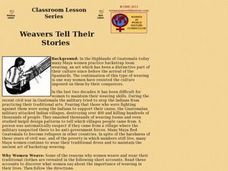Curated OER
South American Wordsearch
In this social studies worksheet, students search for 25 words relating to South America. Words in the word search include names of current countries as well as those of ancient cultures of the area.
Curated OER
Theobroma Cacao "The Food of the Gods"
Sixth graders research the history of chocolate and write short answers to provided questions. They read about the Mayan and Aztec civilizations and the Spanish conquest.
Curated OER
North America Puzzle Answer Sheet
In this geography worksheet, students name the capitals of various countries found in North America. They also identify the various weather patterns across the continent and specific bodies of water. There are 21 descriptions and 21...
Smithsonian Institution
Ceramica de los Ancestros
Scholars join a field expedition team to unearth a plethora of treasures from Central America. Artifacts listed in alphabetical order come with an informational blurb and a picture designed for participants to color. Activity pages...
Curated OER
East to West: Africa's Influence on Mexico
Your historians and social anthropologists study the relationship between peoples of ancient Africa and ancient Mesoamerica. They relate in written or verbal form the African presence in the ancient Americas. They create their own...
Core Knowledge Foundation
Unit 2: Early American Civilizations
Fifth graders explore early American civilizations in a four-week ELA unit. Every lesson offers an opportunity to read and discuss a selected passage followed by word work that covers vocabulary, grammar, and morphology. Learners write...
Curated OER
Weavers Tell Their Stories
Students examine the practice of weaving by Mayan women. They read personal accounts and write a sentence stating the main idea. They also write a short report on weaving as a cultural and economic way of life for the Mayan women.
Curated OER
Teaching the Hindu-Buddhist Tradition in East Asian Culture Through Asian Literature and Film
Students explore various intellectual traditions which dominate human history through a variety of contemporary pieces of literature which exemplify the traditions. Biblical monotheism, Greek rationalism, Hinduism, Buddhism, Confucianism...
Education Outside
Papermaking
Imagine recycling food scraps and using them to make paper. The directions are all here in a seven-page packet that details several paper-making strategies.
Curated OER
Inca Artifacts and Civilization Lesson Plans
By learning about Inca artifacts and this ancient civilization students can delve into history, geography, and much more.
Curated OER
Meet the Mayas, Aztecs and Incas
Students study the geography of the Mayas, Aztecs and Incas and create a map book. They share in stories and legends about these people. Handouts and worksheets are included.
Curated OER
Mathematicians and Scientists Treasure Hunt
Students match a fact with a mathematician or scientist using the Internet. They read about a mathematician or scientist that happens to be female or a person of color.
Curated OER
Oklahoma Stone Soup
Class members complete activities related to the story "Oklahoma Stone Soup." First, pupils read, discuss, and answer questions about the story. Next, to incorporate math into the lesson, learners make stone soup using a variety of...
Curated OER
Horse Character: Ceramics Lesson
Animals oftentimes elicit various characteristics which make them symbolic or representative of human feeling, action, or emotion. The class creates horse characters out of clay to show character action and symbolism. This is a great...
Curated OER
Political Legends and Map Symbols
Students identify the legend and map symbols. In this map skills lesson, students use a world map to find various locations using a map key.
Curated OER
Ball games
For this ball games worksheet, students read a passage about ball games and answer multiple choice questions about it. Students complete 5 multiple choice questions about ball games.
Curated OER
The Physics of the Planets: How 16th and 17th Century Physicist Helped Us Understand Our Solar System
Eighth graders draw the paths of the planets in the solar system. In this astronomy lesson, 8th graders calculate speed of objects using distance and time information. They research about the work of scientists in the 16th and 17th century.
Curated OER
Civilizations of the Americas
Study and compare multiple aspects of both Aztec and Inca civilizations. Young historians explain how each of the empires came to be, and how they were both defeated by the Spanish. The resource starts out as a good lesson, but is...
Curated OER
Dig Magazine Archeology Quiz #109
In this Dig Magazine archeology quiz, students answer 12 multiple choice questions complementing the March 2010 issue. Page contains answer and additional resources link.
Curated OER
CONCEPTS IN NUMBER THEORY.
Students study the Maya culture and their achievements in mathematics, how bacteria grow exponentially, use rational numbers to convert back and forth between Celsius and degrees Fahrenheit, how some architectural designs are examples of...
Facing History and Ourselves
Who Am I?
Sixth graders explore how people throughout time have responded to questions regarding identity. For this The House on Mango Street lesson plan, 6th graders create an identity chart for a fictional character and then write personal...
Facing History and Ourselves
What Does It Mean to Belong?
After reading and analyzing The 'In' Group by Eve Shalen, sixth graders consider how the categorization of people results in exclusion, discrimination, and injustice.
Curated OER
Egyptian Inspiration Web
Young scholars conduct Internet research to discover information about scientific, technological, cultural and intellectual achievements in Egypt, along with Egyptian family life. Students create Inspiration webs of their findings.
Curated OER
Anasazi/Mesoamerican/Andean: Time and Cultural Passages
Seventh graders role play the position of someone in one of six different civilization groups. They research the group's development, advancement and fall of their civilization. They create a presentation to share the information with...

























